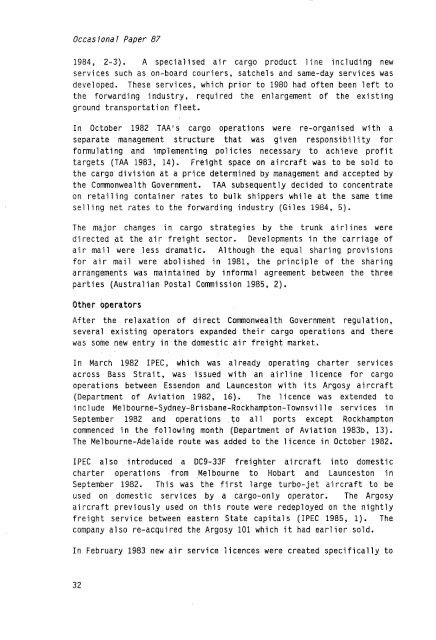Domestic Air Cargo Industry in Australia - Bureau of Infrastructure ...
Domestic Air Cargo Industry in Australia - Bureau of Infrastructure ...
Domestic Air Cargo Industry in Australia - Bureau of Infrastructure ...
Create successful ePaper yourself
Turn your PDF publications into a flip-book with our unique Google optimized e-Paper software.
Occasional Paper 871984, 2-3). A specialised air cargo product 1 <strong>in</strong>e <strong>in</strong>clud<strong>in</strong>g newservices such as on-board couriers, satchels and same-day services wasdeveloped. These services, which prior to 1980 had <strong>of</strong>ten been left tothe forward<strong>in</strong>g <strong>in</strong>dustry, required the enlargement <strong>of</strong> the exist<strong>in</strong>gground transportation fleet.In October 1982 TAA’s cargo operations were re-organised with aseparate management structure that was given responsibility forformulat<strong>in</strong>g and implement<strong>in</strong>g policies necessary to achieve pr<strong>of</strong>ittargets (TAA 1983, 14). Freight space on aircraft was to be sold tothe cargo division at a price determ<strong>in</strong>ed by management and accepted bythe Commonwealth Government. TAA subsequently decided to concentrateon retail<strong>in</strong>g conta<strong>in</strong>er rates to bulk shippers while at the same timesell<strong>in</strong>g net rates to the forward<strong>in</strong>g <strong>in</strong>dustry (Giles 1984, 5).The major changes <strong>in</strong> cargo strategies by the trunk airl<strong>in</strong>es weredirected at the air freight sector. Developments <strong>in</strong> the carriage <strong>of</strong>air mail were less dramatic. Although the equal shar<strong>in</strong>g provisionsfor air mai 1 were abolished <strong>in</strong> 1981, the pr<strong>in</strong>ciple <strong>of</strong> the shar<strong>in</strong>garrangements was ma<strong>in</strong>ta<strong>in</strong>ed by <strong>in</strong>formal agreement between the threeparties (<strong>Australia</strong>n Postal Commission 1985, 2).Other operatorsAfter the relaxation <strong>of</strong> direct Commonwealth Government regulation,several exist<strong>in</strong>g operators expanded their cargo operations and therewas some new entry <strong>in</strong> the domestic air freight market.In March 1982 IPEC, which was already operat<strong>in</strong>g charter servicesacross Bass Strait, was issued with an airl<strong>in</strong>e licence for cargooperations between Essendon and Launceston with its Argosy aircraft(Department <strong>of</strong> Aviation 1982, 16). The licence was extended to<strong>in</strong>clude Melbourne-Sydney-Brisbane-Rockhampton-Townsville services <strong>in</strong>September 1982 and operations to all ports except Rockhamptoncommenced <strong>in</strong> the follow<strong>in</strong>g month (Department <strong>of</strong> Aviation 1983b, 13).The Melbourne-Adelaide route was added to the licence <strong>in</strong> October 1982.IPEC also <strong>in</strong>troduced a DC9-33F freighter aircraft <strong>in</strong>to domesticcharter ,operations from Melbourne to Hobart and Launceston<strong>in</strong>September 1982. This was the first large turbo-jet aircraft to beused on domestic services by a cargo-only operator. The Argosyaircraft previously used on this route were redeployed on the nightlyfreight service between eastern State capitals (IPEC 1985, 1). Thecompany also re-acquired the Argosy 101 which it had earlier sold.In February 1983 new air service licences were created specifically to32
















